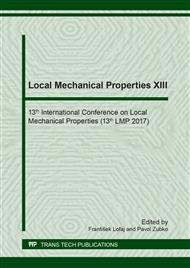[1]
J.J. Vlasak, M. Ciavarella, J.R. Barber, X. Wang, The indentation modulus of elastically anisotropic materials for indenters of arbitrary shape, J. Mech. Phys. Solids 51 (2003) 1701-1721.
DOI: 10.1016/s0022-5096(03)00066-8
Google Scholar
[2]
V. Gaspard, G. Kermouche, D. Delafosse, A. Barnoush, Hydrogen effect on dislocation nucleation in a ferritic alloy Fe-15Cr as observed per nanoindentation, Mater. Sci. Eng. A 604 (2014) 86-91.
DOI: 10.1016/j.msea.2014.02.041
Google Scholar
[3]
L. Ma, D.J. Morris, S.L. Jennerjohn, D.F. Bahr, L.E. Levine, The role of probe shape on the initiation of metal plasticity in nanoindentation, Acta Mater. 60 (2012) 4729-4739.
DOI: 10.1016/j.actamat.2012.05.026
Google Scholar
[4]
A. Materna, P. Haušild, J. Nohava, A numerical investigation of the effect of cubic crystals orientation on the indentation modulus, Acta Phys. Pol. A 128 (2015) 693-696.
DOI: 10.12693/aphyspola.128.693
Google Scholar
[5]
R. Smith, D. Christopher, S.D. Kenny, Defect generation and pileup of atoms during nanoindentation of Fe single crystals, Phys. Rev. B 67 (2002) 245405:1-10.
DOI: 10.1103/physrevb.67.245405
Google Scholar
[6]
M.A. Lodes, A. Hartmaier, M. Goken, K. Durst, Influence of dislocation density on the pop-in behavior and indentation size effect in CaF2 single crystals: Experiments and molecular dynamics simulations, Acta Mater. 59 (2011) 4264-4273.
DOI: 10.1016/j.actamat.2011.03.050
Google Scholar
[7]
J. Prahl, A. Machová, M. Landa, P. Haušild, M. Karlík, A. Spielmannová, M. Clavel, P. Haghi-Ashtiani, Fracture of Fe-3 wt.% Si single crystals, Mater. Sci. Eng. A 462 (2007) 178-182.
DOI: 10.1016/j.msea.2006.02.456
Google Scholar
[8]
A. Spielmannová, M. Landa, A. Machová, P. Haušild, P. Lejček, Influence of crack orientation on the ductile-brittle behavior in Fe-3 wt.% Si single crystals, Mater. Charact. 58 (2007) 892-900.
DOI: 10.1016/j.matchar.2006.09.001
Google Scholar
[9]
W.C. Oliver, G.M. Pharr, An improved technique for determining hardness and elastic modulus using load and displacement sensing indentation experiments, J. Mater. Res. 7 (1992) 1564-1583.
DOI: 10.1557/jmr.1992.1564
Google Scholar
[10]
A. Machová, S. Kadečková, Elastic constants of iron-silicon alloy single crystals, Czech. J. Phys. B 27 (1977) 555-563.
DOI: 10.1007/bf01587133
Google Scholar
[11]
J. Čech, P. Haušild, O. Kovářík, Characterization of structural materials by spherical indentation, Mater. Tehnol. 51 (2017) 695-698.
DOI: 10.17222/mit.2016.302
Google Scholar
[12]
A. Barnoush, H. Vehoff, Recent developments in the study of hydrogen embrittlement: Hydrogen effect on dislocation nucleation, Acta Mater. 51 (2010) 5274-5285.
DOI: 10.1016/j.actamat.2010.05.057
Google Scholar


